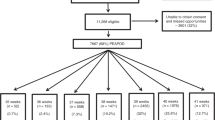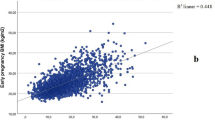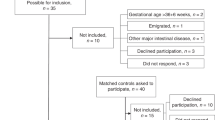Abstract
Objective:
To examine whether the presence of intra-abdominal fat (IAF) in newborns is diagnostic of infants of diabetic mothers (IDMs), and determine whether IAF is merely the consequence of increased body size.
Study Design:
Abdominal radiographs of 277 neonates >34 weeks gestational age (147 male and 130 female) were reviewed to determine the presence of IAF. Unpaired t-test and regression analyses were used to examine the influence of gestational age, birth weight, birth length and maternal diabetes on the prevalence and thickness of IAF.
Result:
The prevalence of IAF was higher in IDMs (41.2% vs 13.2%; P<0.0001)—an association that persisted even after accounting for sex, gestational age and weight. Both birth weight and maternal diabetic status influenced the amount of IAF. Values of IAF thickness in IDMs were, however, more than threefold greater than those in non-IDMs (2.53±2.08 vs 0.81±0.29 mm; P<0.0001). An IAF thickness >1.5 mm was indicative of an IDM.
Conclusion:
The depiction of IAF in radiographs is significantly more prevalent in IDMs when compared with non-IDMs, regardless of body size. A thickness of IAF >1.5 mm is a marker that should encourage work-up for the physiological, metabolic and congenital complications associated with IDM.
This is a preview of subscription content, access via your institution
Access options
Subscribe to this journal
Receive 12 print issues and online access
$259.00 per year
only $21.58 per issue
Buy this article
- Purchase on Springer Link
- Instant access to full article PDF
Prices may be subject to local taxes which are calculated during checkout


Similar content being viewed by others
References
Tikellis G, Ponsonby AL, Wells JC, Pezic A, Cochrane J, Dwyer T . Maternal and infant factors associated with neonatal adiposity: results from the Tasmanian Infant Health Survey (TIHS). Int J Obes (Lond) 2012; 36: 496–504.
Calkins K, Devaskar SU . Fetal origins of adult disease. Curr Probl Pediatr Adolesc Health Care 2011; 41: 158–176.
Ramos GA, Moore TR. Endocrine disorders in pregnancy. In: Gleason CA, Devaskar SU (eds). Avery's Diseases of the Newborn. Saunders Elsevier: Philadelphia, PA, USA, 2012, pp 75–91.
Cryer PE. Hypoglycemia. In: Melmed S, Polonsky KS, Larsen PR, Kronenberg HM, (eds). Williams Textbook of Endocrinology. Saunders Elsevier: Philadelphia, PA, USA, 2011, pp 1552–1580.
Brumbaugh DE, Tearse P, Cree-Green M, Fenton LZ, Brown M, Scherzinger A et al. Intrahepatic fat is increased in the neonatal offspring of obese women with gestational diabetes. J Pediatr 2013; 162: 930–936, e931.
Chung H, Jacks T, Lilien LD . Properitoneal fat mimicking free air in an infant of a diabetic mother. J Perinatol 2011; 31: 687–688.
Aman J, Hansson U, Ostlund I, Wall K, Persson B . Increased fat mass and cardiac septal hypertrophy in newborn infants of mothers with well-controlled diabetes during pregnancy. Neonatology 2011; 100: 147–154.
Catalano PM, Thomas A, Huston-Presley L, Amini SB . Increased fetal adiposity: a very sensitive marker of abnormal in utero development. Am J Obstet Gynecol 2003; 189: 1698–1704.
Khan NA . Role of lipids and fatty acids in macrosomic offspring of diabetic pregnancy. Cell Biochem Biophys 2007; 48: 79–88.
Herrera E, Amusquivar E . Lipid metabolism in the fetus and the newborn. Diabetes Metab Res Rev 2000; 16: 202–210.
Kitajima M, Oka S, Yasuhi I, Fukuda M, Rii Y, Ishimaru T . Maternal serum triglyceride at 24—32 weeks' gestation and newborn weight in nondiabetic women with positive diabetic screens. Obstet Gynecol 2001; 97: 776–780.
Schaefer-Graf UM, Graf K, Kulbacka I, Kjos SL, Dudenhausen J, Vetter K et al. Maternal lipids as strong determinants of fetal environment and growth in pregnancies with gestational diabetes mellitus. Diabetes Care 2008; 31: 1858–1863.
Harmon KA, Gerard L, Jensen DR, Kealey EH, Hernandez TL, Reece MS et al. Continuous glucose profiles in obese and normal-weight pregnant women on a controlled diet: metabolic determinants of fetal growth. Diabetes Care 2011; 34: 2198–2204.
Festa R, Carta M, Ceriello A, Testa R . Time is glucose, can't miss gestational diabetes. Diabetes Technol Ther 2012; 14: 444–446.
Author information
Authors and Affiliations
Corresponding author
Ethics declarations
Competing interests
The authors declare no conflict of interest.
Rights and permissions
About this article
Cite this article
Ponrartana, S., Goodarzian, F., Emadi, S. et al. Radiographic depiction of intra-abdominal fat in newborns: a marker of infants born to diabetic mothers. J Perinatol 36, 389–391 (2016). https://doi.org/10.1038/jp.2015.210
Received:
Revised:
Accepted:
Published:
Issue Date:
DOI: https://doi.org/10.1038/jp.2015.210



